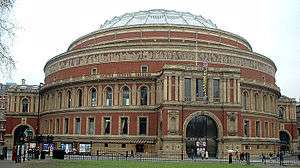Lucas Brothers (company)
Lucas Brothers was a leading British building business based in London.
| Private | |
| Industry | Construction |
| Fate | Dissolved |
| Founded | 1842 |
| Defunct | 1895 |
| Headquarters | London, England |
Key people | Charles Lucas, (chairman) |
Early history
The business was founded by Charles Thomas Lucas (1820 London – 1895 Warnham Court, near Horsham)[1] and Thomas Lucas (1822–1902). They were the sons of James Lucas (1792–1865), a builder from St Pancras, London. Charles joined his father's business and was soon employed to manage construction of the Norwich & Brandon Railway for Sir Samuel Morton Peto.[2]
In 1842 Charles set up his own contracting business in Norwich and progressed to rebuilding Peto's house, Somerleyton Hall.[2] Charles and Thomas established a facility in Lowestoft from which they undertook various works, including the railway, the station, the Esplanade, St John's church, and several hotels.[2]

Building contracts
Perhaps their most famous building contract was the Royal Albert Hall completed in 1871.[3] They also built Covent Garden Opera House (completed in 1858),[2] Floral Hall (1860),[2] King's College Hospital (1862),[2] the Junior Carlton Club (1866),[2] Charterhouse School (1872),[2] and the Alexandra Palace (1873).[4] Private houses included Cliveden (1851),[2] Henham Hall (1858),[2] Rendlesham Hall (1870),[2] Normanhurst Court (1870),[2] and the South Kensington Exhibitions of 1867 and 1871 with Sir John Kelk.[2]
Structure
After the company began collaborating with John Aird & Co., their combined businesses were re-organised in 1870 as follows:[5]
- Lucas Brothers – Building
- Lucas and Aird – Railway work and civil engineering
- John Aird & Sons – Water and gas contracts
In 1895, when Sir Charles Lucas died, Lucas Brothers and Lucas and Aird were dissolved.[5]
About the founders
Charles Thomas Lucas married Charlotte Tiffin and had five sons and two daughters. He lived in London and then at Warnham in Sussex. He was created a Baronet in 1887.[2] Thomas Lucas married Jane Golder and had a daughter. After her death, he married Mary Amelia Chamberlin, daughter of Robert Chamberlin of Norwich, and had six sons and four daughters. He lived in London, Ascot, and briefly at Ashtead in Surrey.[6]
References
- "Charles Thomas Lucas". Grace's Guide to British Industrial History. Retrieved 6 June 2017.
- "Charles Thomas Lucas". Oxford Dictionary of National Biography. Oxford University Press. 2004.
- British History Online (ref. 124)
- National Archives: Correspondence of Charles Thomas Lucas
- "Portraits by the friend of Sherlock Holmes discovered in the City of Westminster" (PDF). Westminster Council. Retrieved 20 November 2019.
- "Sir Thomas Lucas". The Peerage. Retrieved 30 November 2019.
Further reading
- The Master Builders by Robert Keith Middlemas, Hutchinson, 1963, ASIN B0000CLXYL
- Sir Samuel Morton Peto by Rev Dr Edward C Brooks, Brookes, 1996, ISBN 978-0-9502988-4-9
- Deptford, Toronto and Kingston by Peter Stirling-Aird, Grimsay Press, 2005, ISBN 978-1-84530-021-0